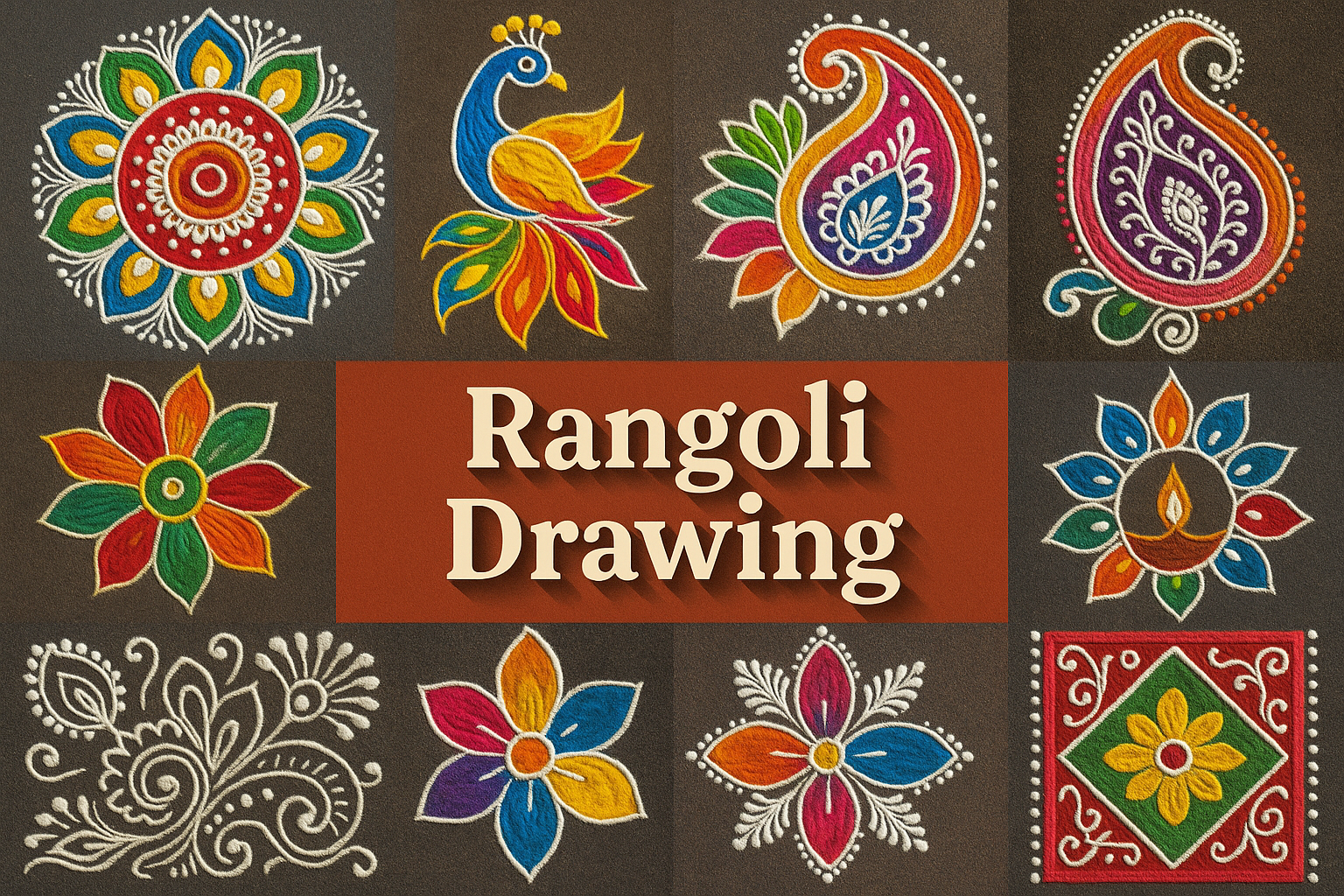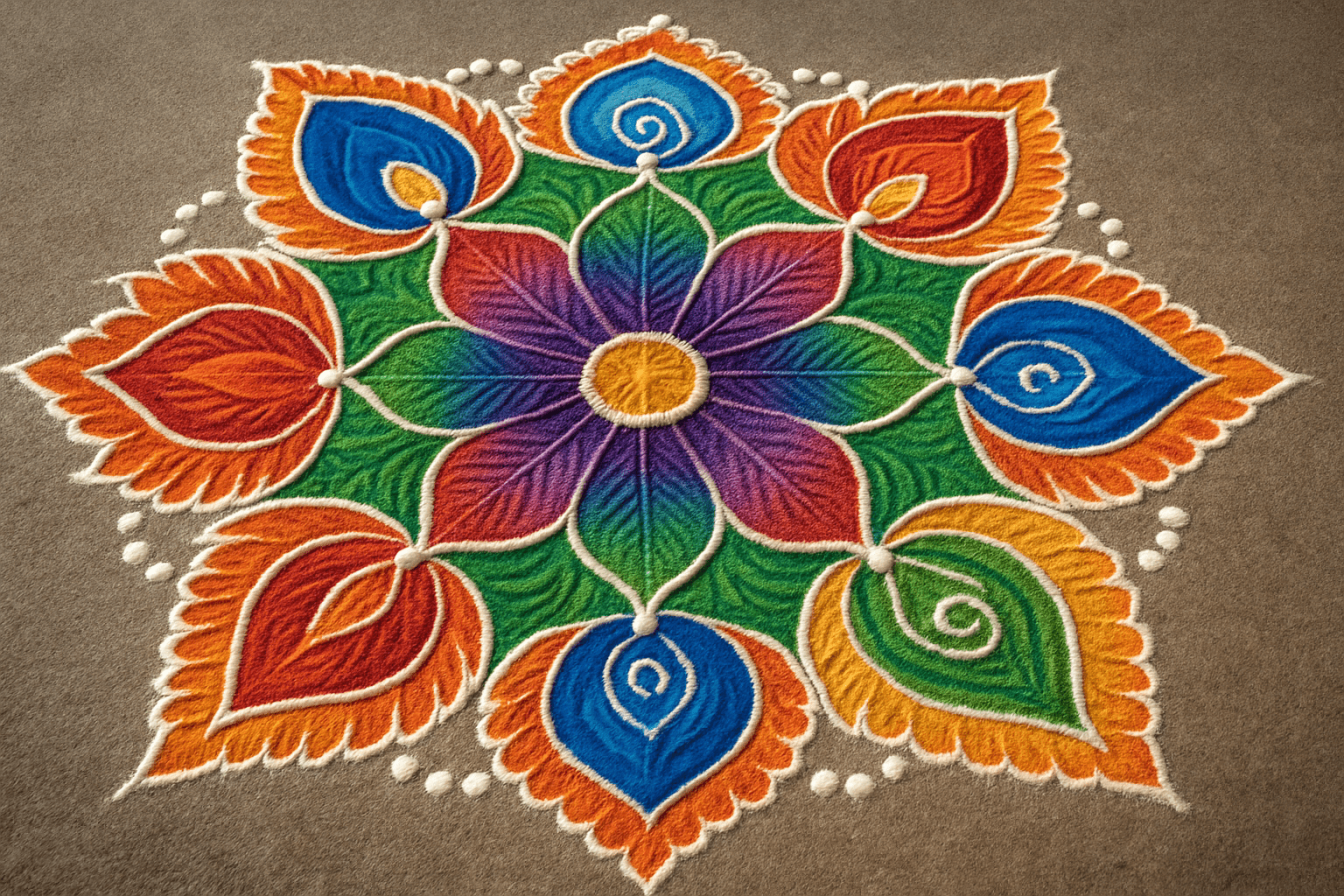
Rangoli Drawing
Rangoli drawings are usually brightly colored and intricate. They often feature geometric patterns and Hindu symbols.
AOI thinking about Rangoli Drawing [+_~]-/
Overview and Quickfacts
Rangoli drawing is a type of Indian folk art that involves creating patterns and designs on the ground using colorful powders. The designs are usually geometric in nature and can be created freehand or using stencils. Rangoli drawing is traditionally done during festivals and special occasions as a way to decorate homes and public spaces.
Can understand it also, as:
Kolam, Muggu, Chalk Art
Categorize it as:
Impressionism, Modernism
.: Dreaming :.
holds a HAIKU for the art style
:. Thought is power .:
Detailed Description
Rangoli is an Indian art form in which patterns are created on the ground using materials like colored rice, dry flour, and sand. The designs are usually geometric, symmetrical, and colorful. Rangoli is traditionally done by women in India as a way to decorate their homes during festivals and special occasions. Rangoli has been around for centuries and has been mentioned in texts dating back to the 12th century. The earliest known rangoli designs were simple geometric patterns. Over time, the designs became more complex and elaborate, often incorporating elements from nature, such as flowers and birds. Today, rangoli is still a popular art form in India. Many modern artists have created their own unique style of rangoli, incorporating elements from other art forms, such as painting and sculpture. Famous rangoli artists include M.F. Hussain, who is known for his colorful and abstract designs, and Sudha Chandrasekhar, who creates detailed, symmetrical patterns. If you’re interested in trying your hand at rangoli, there are many resources available online and in books. All you need is a little patience and creativity!
.. beep, beep, beep ..
<START OF TRANSMISSION>
1. Rangoli is an Indian folk art that has been practiced for centuries. 2. Rangoli is traditionally drawn on the ground using rice flour, sand, or flower petals. 3. Rangoli designs can be simple or complex, and often depict Hindu deities or symbols. 4. Rangoli is typically drawn during festivals or special occasions, such as weddings. 5. The art of Rangoli is said to bring good luck and ward off evil spirits. 6. Rangoli drawing is a meditative and relaxing activity that can be enjoyed by people of all ages. 7. Rangoli designs can be created freehand or using stencils. 8. Rangoli is typically drawn in white, but other colors can be used as well. 9. Rangoli designs can be enhanced with the use of sparkles, beads, or other embellishments. 10. Rangoli is a popular form of street art in India, and can often be seen on sidewalks and walls. 11. Rangoli has been featured in several Bollywood films, and has become a popular tourist attraction in India. 12. Rangoli is believed to date back to the 12th century, and is thought to have originated in the southern Indian state of Kerala. 13. The word ÃÂÃÂrangoliÃÂÃÂ comes from the Sanskrit word ÃÂÃÂrangavalliÃÂÃÂ, which means ÃÂÃÂrow of colorsÃÂÃÂ. 14. Rangoli is also known as ÃÂÃÂkolamÃÂÃÂ, ÃÂÃÂmandanaÃÂÃÂ, or ÃÂÃÂmugguÃÂÃÂ. 15. Rangoli designs are often created using a grid system, with each square or rectangle representing a different color or element. 16. Rangoli can be created using a wide variety of materials, including rice, flour, sand, flower petals, and even coffee. 17. Rangoli designs are typically symmetrical, and often incorporate geometric shapes such as circles, triangles, and squares. 18. Rangoli is traditionally a Hindu art form, but has been adopted by people of other religions as well. 19. Rangoli is said to represent the cosmos, and is often used as a form of meditation. 20. Rangoli is a popular form of art in many parts of the world, and is often used to decorate homes and businesses.
<EOF>
.. robbel bob
Visual Examples from our image gallery
Coming soon, we are so slow .. might never come
Artists, Paintings, and more
(be aware, can be highly speculative)
Artists (be aware, speculation possible):
1. Raja Ravi Varma (1848-1906) 2. M. F. Husain (1915-2011) 3. F. N. Souza (1924-2002) 4. S. H. Raza (1922-2016) 5. Akbar Padamsee (1928-2020) 6. Tyeb Mehta (1925-2009) 7. Vasudeo S. Gaitonde (1924-2001) 8. Krishen Khanna (1922-2020) 9. Laxma Goud (1940-2002) 10. J. Swaminathan (1928-1994) 11. Arpana Caur (born 1955) 12. B. Prabha (born 1944) 13. Bhupen Khakhar (1934-2003) 14. Chandigarh Lalit Kala Akademi (founded 1952) 15. G. R. Santosh (born 1953) 16. H. R. Giger (1940-2014) 17. Jamini Roy (1887-1972) 18. K. G. Subramanyan (1922-2016) 19. Laxma Goud (born 1940) 20. M. F. Husain (1915-2011) 21. N. S. Bendre (1910-1992) 22. O. P. Sharma (born 1951) 23. P. T. Reddy (born 1957) 24. Raja Ravi Varma (1848-1906) 25. S. H. Raza (1922-2016) 26. S. K. Bakre (born 1949) 27. T. M. Krishna (born 1976) 28. V. S. Gaitonde (1924-2001) 29. Vasudeo S. Gaitonde (1924-2001) 30. Vijay Sharma (born 1951)
Artworks (be aware, speculation possible)
1. “Rangoli” by Vasudeo S. Gaitonde (1975) 2. “Rangoli with Dots” by M. F. Husain (1976) 3. “Rangoli” by J. Swaminathan (1977) 4. “Rangoli” by Akbar Padamsee (1978) 5. “Rangoli” by Krishen Khanna (1979) 6. “Rangoli” by Laxma Goud (1980) 7. “Rangoli” by S. H. Raza (1981) 8. “Rangoli” by F. N. Souza (1982) 9. “Rangoli” by J. Swaminathan (1983) 10. “Rangoli” by M. F. Husain (1984) 11. “Rangoli” by J. Swaminathan (1985) 12. “Rangoli” by F. N. Souza (1986) 13. “Rangoli” by M. F. Husain (1987) 14. “Rangoli” by J. Swaminathan (1988) 15. “Rangoli” by Krishen Khanna (1989) 16. “Rangoli” by M. F. Husain (1990) 17. “Rangoli” by J. Swaminathan (1991) 18. “Rangoli” by F. N. Souza (1992) 19. “Rangoli” by M. F. Husain (1993) 20. “Rangoli” by J. Swaminathan (1994) 21. “Rangoli” by Krishen Khanna (1995) 22. “Rangoli” by M. F. Husain (1996) 23. “Rangoli” by J. Swaminathan (1997) 24. “Rangoli” by F. N. Souza (1998) 25. “Rangoli” by M. F. Husain (1999) 26. “Rangoli” by J. Swaminathan (2000) 27. “Rangoli” by Krishen Khanna (2001) 28. “Rangoli” by M. F. Husain (2002) 29. “Rangoli” by J. Swaminathan (2003) 30. “Rangoli” by F. N. Souza (2004)
Epoch
The Rangoli Drawing art style began in India during the Gupta period in the 4th century CE.
AI ART RESSOURCES (AKA, well Tools)
Helping tools -> predefined search links on other pages:











